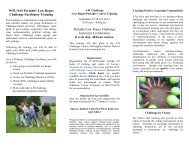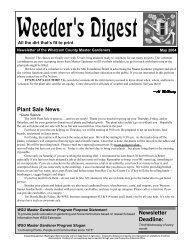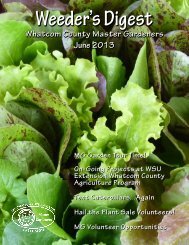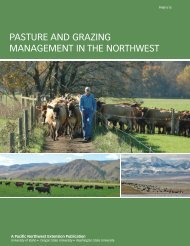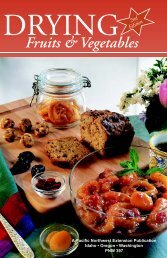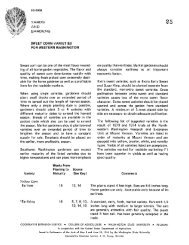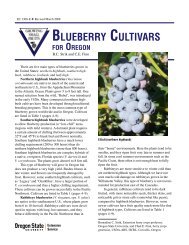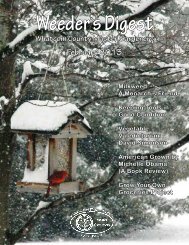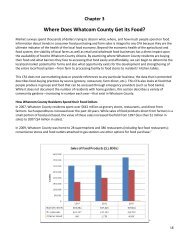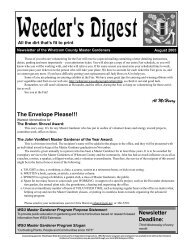Feeding Sheep - Virginia Cooperative Extension - Virginia Tech
Feeding Sheep - Virginia Cooperative Extension - Virginia Tech
Feeding Sheep - Virginia Cooperative Extension - Virginia Tech
You also want an ePaper? Increase the reach of your titles
YUMPU automatically turns print PDFs into web optimized ePapers that Google loves.
<strong>Feeding</strong> <strong>Sheep</strong><br />
Steven H. Umberger*<br />
publication 410-853<br />
Nutrition plays a major role in the overall productivity,<br />
health, and well-being of the sheep flock. Because feed<br />
costs account for approximately two-thirds of the total cost<br />
of production on most <strong>Virginia</strong> sheep farms, it is important<br />
that producers consider nutrition management a top priority.<br />
Nutrient requirements of sheep vary with differences in<br />
age, body weight, and stage of production. The five major<br />
categories of nutrients required by sheep are: 1) water;<br />
2) energy; 3) protein; 4) vitamins; and 5) minerals. During<br />
the grazing season, sheep are able to meet their nutrient<br />
requirements from pasture and a salt and mineral supplement.<br />
Hay is provided to the flock when forages are limited,<br />
and grain may be added to the diet at certain stages<br />
of production when additional nutrient supplementation<br />
is required. Small grain pastures or stockpiled fescue can<br />
supply up to one-half of the feed requirements of the ewe<br />
flock during the winter. For winter-born lambs, creep diets<br />
and diets for early-weaned lambs are formulated from high<br />
energy feed grains and protein supplements to promote<br />
accelerated growth. During the grazing season, pastures<br />
of mixed grass and clover, alfalfa, small grain, and turnip<br />
serve as excellent sources of nutrition for growing lambs.<br />
A source of clean, fresh water is provided to sheep at all<br />
times.<br />
<strong>Feeding</strong> the Ewe Flock<br />
Ewe body weight does not remain constant throughout<br />
the year, but changes with stage of production. Nutrient<br />
requirements are lowest for ewes during maintenance,<br />
increase gradually from early to late gestation, and are<br />
highest during lactation. Decisions affecting feeding management<br />
are improved significantly by knowing ewe body<br />
weight and condition score at three distinct stages of production:<br />
1) three weeks before breeding; 2) mid-gestation;<br />
and 3) weaning. Condition score is a subjective measure of<br />
body fat that is most easily determined by handling ewes<br />
down their back. It is the best method available to monitor<br />
nutritional status and overall well-being of the sheep flock.<br />
Condition scores range from 0 to 5, with 0 being extremely<br />
thin and 5 being very fat. Condition scores at either end of<br />
the scale are undesirable. Ideally, ewes should range from<br />
a condition score of 2.5 at weaning to a 3.5 at lambing.<br />
When necessary, thin ewes are separated and fed additional<br />
energy to increase body condition. Conversely, obese ewes<br />
are separated and fed a lower energy diet at a stage of production<br />
when body weight loss is acceptable. It should be<br />
noted that problems with overfat ewes are far fewer than<br />
those associated with ewes that are too thin.<br />
Starting two weeks before breeding and continuing two<br />
weeks into the breeding period, ewes should be placed<br />
on high-quality pasture or supplemented daily with .75 to<br />
1 pound whole shelled corn or barley. This management<br />
practice is called flushing and has been shown to improve<br />
lambing percentage by 10 to 20 percent. Flushing works<br />
best with mature ewes that are in moderate body condition,<br />
and has been shown to be more effective for early- and outof-season<br />
breeding than at the seasonal peak of ovulation<br />
during the fall. Most prenatal deaths occur within the first<br />
25 days after breeding and are usually associated with poor<br />
nutrition. Therefore, it is important not to make dramatic<br />
reductions in nutrient supplies during the breeding season.<br />
Pastures with more than 50 percent clover or other legumes<br />
should be avoided during breeding because legumes may<br />
contain estrogenic compounds that reduce conception rates.<br />
From breeding to six weeks before lambing, the ewe flock<br />
can be maintained on permanent pastures, small grain<br />
pastures, stockpiled fescue, aftermath crop fields, or hay.<br />
Fetal growth is minimal, and the total feed requirement of<br />
the ewe is not significantly different from a maintenance<br />
diet. The developing fetus acquires approximately twothirds<br />
of its weight during the last six weeks of pregnancy.<br />
Rumen capacity may be limited with ewes carrying multiple<br />
fetuses. Therefore, it is important to supplement ewes<br />
with .75 to 1 pound of corn or barley in addition to their<br />
normal diet starting six weeks before lambing, to prevent<br />
pregnancy toxemia, low birth weights, weak lambs at birth,<br />
and low milk production. Producers should be careful not<br />
to overfeed grain during late gestation, which could result<br />
in lambing difficulty caused by large lambs.<br />
www.ext.vt.edu<br />
Produced by Communications and Marketing, College of Agriculture and Life Sciences,<br />
<strong>Virginia</strong> Polytechnic Institute and State University, 2009<br />
<strong>Virginia</strong> <strong>Cooperative</strong> <strong>Extension</strong> programs and employment are open to all, regardless of race, color, national origin, sex, religion,<br />
age, disability, political beliefs, sexual orientation, or marital or family status. An equal opportunity/affirmative action employer.<br />
Issued in furtherance of <strong>Cooperative</strong> <strong>Extension</strong> work, <strong>Virginia</strong> Polytechnic Institute and State University, <strong>Virginia</strong> State University,<br />
and the U.S. Department of Agriculture cooperating. RIck D. Rudd, Interim Director, <strong>Virginia</strong> <strong>Cooperative</strong> <strong>Extension</strong>, <strong>Virginia</strong><br />
<strong>Tech</strong>, Blacksburg; Alma C. Hobbs, Administrator, 1890 <strong>Extension</strong> Program, <strong>Virginia</strong> State, Petersburg.
After lambing, the energy and protein requirements of the<br />
ewe increase by 30 and 55 percent, respectively. Failure<br />
to supplement ewes accordingly results in excessive body<br />
weight loss, low milk production, mismothering, and poor<br />
lamb gains. Protein supplementation is especially critical<br />
for ewe flocks with a high percentage of multiple births.<br />
Unless high quality legume hays are fed, protein supplementation<br />
will be necessary as a part of the grain portion of<br />
the diet. A general rule of thumb for concentrate feeding<br />
of lactating ewes is 1 pound of grain for each lamb nursing<br />
the ewe. Ewes should be sorted into feeding groups based<br />
on type of rearing (single, twin, etc.) to make sure grain<br />
supplements are neither over- or underfed. Table 1 gives<br />
the TDN and crude protein requirements of ewes based<br />
on body weight and stage of production. By knowing the<br />
nutrient requirements of the ewe and the nutrient content of<br />
the feed, diets can be properly formulated to meet the nutritional<br />
needs of the ewe. Shown in Table 2 are the estimated<br />
quantities of hay, corn and soybean meal that would be fed<br />
to a 175 pound ewe at different stages of production and<br />
with different crude protein values for the hay. To successfully<br />
use this table, hay samples should be submitted to a<br />
testing lab to determine its crude protein content.<br />
<strong>Feeding</strong> Lambs<br />
<strong>Feeding</strong> programs in <strong>Virginia</strong> for growing and finishing<br />
lambs are different for winter- and spring-lambing production<br />
systems. Lambs born from November through early<br />
February will likely be grown and finished on high concentrate<br />
feeds. Lambs born after the middle of February<br />
are placed on pasture with their dams where they remain<br />
throughout the spring and summer. If necessary, springborn<br />
lambs are weaned and finished to market weight in<br />
the fall, using a grain on grass feeding program or placed<br />
in a feedlot for an abbreviated period of high concentrate<br />
feeding.<br />
Lambs on a winter-lambing program should have access to<br />
a high quality creep feed by the time they are seven days<br />
old. Creep feeds should contain 18 to 20 percent crude<br />
protein and be low in fiber (high in energy). The source of<br />
protein in commercially prepared lamb creep pellets should<br />
be all natural protein. Because the rumen of young lambs<br />
is not fully developed, urea should not be used as a partial<br />
source of protein in the diet. A 2:1 calcium to phosphorous<br />
ratio is maintained in on-farm feed mixes by adding feed<br />
grade limestone at 1 percent of the diet. Calcium to phosphorous<br />
ratios of less than 2:1 may lead to urinary calculi<br />
(water belly), which most often results in the death of the<br />
lamb. If the addition of limestone to the diet fails to control<br />
urinary calculi, ammonium chloride should be added<br />
at .5 percent of the diet. When constructing a creep area,<br />
keep the following points in mind: 1) place the creep in a<br />
convenient location close to an area where the ewe flock<br />
congregates; 2) have openings on at least two sides of the<br />
creep and several openings per side; 3) keep the creep area<br />
clean and well bedded; 4) place a light over the creep to<br />
help attract the lambs to the feed or arrange the creep in<br />
such a way that the sun shines into the area during the day;<br />
5) provide fresh water in the creep area; and 6) construct<br />
the creep feeder so that lambs cannot stand and play in it.<br />
Allow 2 inches of trough space per lamb.<br />
Winter-born lambs should be weaned and adjusted to a<br />
growing diet by the time they are two months of age. A<br />
growing diet for lambs weighing 40 to 70 pounds should<br />
Table 1. Changes in the Daily Total Digestible Nutrients (TDN) and Protein Requirements of a Ewe from Maintenance Through Early<br />
Lactation.<br />
Ewe weight<br />
Stage of production<br />
130 lb a 155 lb a 175 lb a 200 lb a<br />
TDN Protein TDN Protein TDN Protein TDN Protein<br />
Maintenance 1.30 0.23 1.50 0.25 1.60 0.27 1.70 0.29<br />
Early pregnancy 1.60 0.27 1.70 0.29 1.80 0.31 1.90 0.33<br />
Late pregnancy b 2.60 0.45 2.80 0.47 2.90 0.49 3.00 0.51<br />
Early lactation, single 3.30 0.70 3.60 0.73 3.70 0.76 3.80 0.78<br />
Early lactation, twins 3.70 0.89 4.00 0.92 4.30 0.96 4.60 0.99<br />
Early lactation, triplets c 3.90 0.99 4.20 1.02 4.60 1.06 5.00 1.10<br />
a<br />
Based on ewe weight at breeding time.<br />
b<br />
National Research Council recommendations for ewes expected to have a 180-to 225-percent lamb crop. If 130-to 150-percent lamb<br />
crop is expected, then you can reduce total digestible nutrients by 0.4 pound and protein by 0.05 pound.<br />
c<br />
Estimates made by adding on one-half of the difference between ewes nursing singles and twins to the amount indicated for ewes<br />
nursing twins.<br />
2<br />
lb
Table 2. The Amount of Hay, Shelled Corn (SC), and Soybean Meal (SBM) Required to Meet the Total Digestible Nutrients (TDN)<br />
and Crude Protein (CP) Requirements of a 175-lb Ewe When the Hay Contains Different Protein Levels.<br />
Percent protein in hay*<br />
Stage of production<br />
16.5 15.0 12.5 10.0<br />
Maintenance Hay 3.25 3.25 3.25 3.25<br />
Early pregnancy Hay 3.75 3.75 3.75 3.75<br />
Late pregnancy Hay 4.20 4.20 4.20 4.20<br />
SC 1.00 1.00 1.00 1.00<br />
SBM — — — 0.10<br />
Early lactation (single) Hay 5.00 5.00 5.00 5.00<br />
SC 1.50 1.50 1.40 1.15<br />
SBM — — 0.10 0.40<br />
Early lactation (twins) Hay 5.00 5.00 5.00 5.00<br />
SC 2.25 2.15 1.90 1.50<br />
SBM — 0.10 0.40 0.75<br />
Early lactation (triplets) Hay 3.50 3.50 3.50 3.50<br />
SC 3.15 2.95 2.70 2.45<br />
SBM 0.45 0.65 0.90 1.15<br />
Note: Adjusted from dry matter values: Corn - 80 percent TDN and 8.8 percent CP, SBM -80 percent TDN and 44 percent CP, Hay -<br />
50 percent TDN. TDN of hay increases as hay quality increases, but is left constant here for ease of discussion and diet calculations.<br />
*Percentages are figured on an as-fed basis, as are the pounds of feed.<br />
lb<br />
contain approximately 78 percent TDN and 16 percent<br />
crude protein. At body weights of 70 pounds and up, the<br />
level of crude protein in the diet can be lowered to 14 percent.<br />
Feed efficiency values range from 2 pounds of feed<br />
per pound of gain for light weight young, growing lambs<br />
on up to 3.5 to 4 pounds of feed per pound of gain as winter-born<br />
lambs approach their optimum market weight.<br />
Feed efficiency values for old-crop (spring born) feeder<br />
lambs weighing 75 pounds and up in the fall average 5 to<br />
5.5 pounds of feed per pound of gain when a whole-grain<br />
feeding program is used. Whole-grain feeding improves<br />
feed efficiency, increases rate of gain, and lowers the feed<br />
cost per pound of lamb gain. Whole-grain diets consist of<br />
whole (unprocessed) grains, such as shelled corn or barley,<br />
mixed with a pelleted protein-mineral supplement. No<br />
roughage is contained in the feed or supplemented on the<br />
side. Consequently, the diet is high in energy and promotes<br />
accelerated lamb gains.<br />
Ground ear corn, silage, and urea should not be fed until<br />
lambs are weighing 65 pounds and up. Creep diets should<br />
be ground or pelleted. Weaned lamb growing and finishing<br />
diets may be ground, pelleted, or consist of a mixture of<br />
whole grain and a pelleted supplement.<br />
Ram <strong>Feeding</strong><br />
Rams should have a body condition score of 3.5 to 4 before<br />
the beginning of the breeding season. Once turned in with<br />
the ewes for breeding, rams spend very little time eating.<br />
They can lose up to 12 percent of their body weight during<br />
a 45-day breeding period. That equates to 30 pounds for a<br />
250 pound ram. Poor nutrition is a major cause of ram mortality.<br />
As the sheep industry has moved away from smaller<br />
framed, earlier maturing types of sheep to larger framed,<br />
later maturing types of sheep, they have increased the rams’<br />
mature body weight. In many cases, forage alone is not<br />
adequate nutrition for placing rams in proper body condition<br />
for the breeding season. At the very least, rams should<br />
be evaluated for body condition six weeks before breeding.<br />
Thin rams should receive grain supplementation as a<br />
means to increase body weight and condition. It takes 50<br />
days and approximately 2.5 pounds of corn per day in addition<br />
to a ram’s normal diet to move him from a weight of<br />
225 pounds to 250 pounds. Mature rams, not in breeding,<br />
can be maintained on pasture or wintered on good quality<br />
hay. Six to eight pounds of mixed grass and clover hay is<br />
sufficient to meet the daily energy requirements of a 250<br />
pound ram. A free choice source of water, salt, and minerals<br />
should be available at all times.<br />
3
Feeds for <strong>Sheep</strong><br />
Pasture - Permanent pasture should be the predominant<br />
source of nutrition for the sheep flock. Intensive sheep<br />
production systems where the sheep are housed and fed<br />
harvested feeds are not as profitable as more extensive<br />
production systems where they harvest their own feed.<br />
When a sufficient quantity of forage is available, sheep<br />
are able to meet their nutrient requirements from forage<br />
alone along with a supplemental source of salt and<br />
minerals. Clover should be overseeded on permanent<br />
pastures in the winter to improve the quantity and quality<br />
of forage produced during the grazing season. <strong>Sheep</strong><br />
prefer to graze leafy, vegetative growth that is 2 to 6<br />
inches tall rather than stemmy, more mature forages.<br />
Pasture growth is not distributed evenly throughout the<br />
year. Approximately 60 percent of the annual dry matter<br />
production of most species of cool season grasses<br />
occurs in the spring. When pastures are not stocked<br />
heavily enough to utilize the spring flush of growth,<br />
sheep graze and regraze certain areas while other areas<br />
are left to mature and go to seed. This type of grazing<br />
behavior weakens those plants that are grazed more<br />
frequently and gives the less desirable plants a competitive<br />
advantage. Approximately one-third of spring<br />
pasture should be fenced for hay production. After a hay<br />
cutting, pasture should be given a three- to four-week<br />
recovery period before making it available for grazing<br />
the remainder of the year. Rotational grazing programs<br />
designed for the movement of sheep every 10 to 14 days<br />
are instituted in late June and early July to improve both<br />
pasture and lamb production. More intensive rotational<br />
grazing systems where higher stocking rates are used<br />
help to promote more complete forage utilization, but<br />
also require greater input costs in the form of fence<br />
and water and may result in higher levels of internal<br />
parasitism, increased risk of coccidiosis, and impaired<br />
lamb performance.<br />
Hay - Average or poor quality hay should be fed during<br />
gestation, leaving the higher quality hay to be fed<br />
during lactation. Because protein requirements of the<br />
ewe increase dramatically after lambing, less protein<br />
supplementation from concentrate feeds is required<br />
when higher quality hay is used. Second-cutting, mixed<br />
grass-clover hay may be more economical to feed to<br />
the ewe flock than alfalfa hay. This is especially true<br />
if alfalfa hay must be purchased from off the farm.<br />
Alfalfa hay is an excellent feed for sheep and is best<br />
used during lactation when ewes require more protein<br />
to promote higher levels of milk production. Many<br />
producers have fed alfalfa hay to gestating ewes with<br />
good results. However, some producers feeding alfalfa<br />
hay to gestating ewes have experienced problems with<br />
vaginal prolapses, late term abortions, and milk fever.<br />
If alfalfa hay is being fed during late gestation, it should<br />
be limit fed and be free of must and mold. Because of<br />
its high quality and palatability, ewes consume more<br />
alfalfa hay than is needed. The bulkiness of the hay<br />
in the rumen may place pressure on the reproductive<br />
tract, resulting in a vaginal prolapse before lambing.<br />
Ewes receiving alfalfa hay during gestation are more<br />
prone to milk fever than ewes fed grass hay. Because<br />
alfalfa is high in calcium, ewes are able to meet their<br />
calcium requirements without mobilizing body stores of<br />
calcium. However, after lambing, ewes not accustomed<br />
to mobilizing bone calcium may experience milk fever<br />
because of their inability to meet the additional calcium<br />
requirements associated with lactation. Regardless of the<br />
type of hay fed, producers should submit hay samples<br />
to a forage testing lab to determine its nutrient content.<br />
By knowing the nutrient content of the hay, diets can<br />
be more accurately and economically formulated for<br />
the sheep flock.<br />
In general, there is less waste and more flexibility<br />
when feeding hay harvested as square bales. However,<br />
round bales can provide quality feed for sheep when<br />
stored and fed properly. To minimize dry matter and<br />
nutrient losses, which can approach 40 to 50 percent,<br />
round bales should be covered with plastic for outside<br />
storage or placed under shelter. Bales should be stored<br />
on pallets or tires to prevent ground contact. <strong>Feeding</strong><br />
round bales without a feeder may result in as much as<br />
30 percent of the hay being wasted, and poses a hazard<br />
to the sheep should the bales roll over. A variety of<br />
round bale feeders are commercially available. Feeders<br />
designed in the shape of a cradle hold the bales up off<br />
the ground, are maintenance free, and appear to work<br />
best for minimizing waste.<br />
Silage - High quality, finely chopped (1/4 to 1/2 inch) corn,<br />
grass, or small grain silage is acceptable feed for sheep.<br />
Care must be taken to properly harvest, store, and feed<br />
silage. Poorly packed silage may contain harmful molds,<br />
which causes listeriosis (circling disease) in sheep.<br />
Moldy or frozen silage should be discarded and troughs<br />
should be cleaned daily. Corn silage is low in protein<br />
and calcium. Studies have shown that the addition of<br />
20 pounds of urea, 10 pounds of ground limestone,<br />
4 pounds of dicalcium phosphate, and 5 pounds of<br />
calcium sulfate per ton of silage at the time of ensiling<br />
makes a complete feed for the ewe flock by increasing<br />
its crude protein and calcium content. Alternatively,<br />
extra protein, calcium, phosphorous, and vitamins can<br />
be supplied through a grain mix topdressed on the silage<br />
at the time of feeding.<br />
Because of its high moisture content, 3 pounds of silage<br />
is required to supply the TDN furnished by 1.5 pounds<br />
of hay. The bulkiness of silage prevents adequate dry<br />
matter intake and its use as the sole source of feed for<br />
ewes in late gestation. A typical diet fed to ewes during<br />
the last four weeks of pregnancy on an as fed basis<br />
4
would contain: 6 pounds of corn silage (35 percent dry<br />
matter), 2 pounds of hay, 0.5 pound of corn, and 0.25<br />
pound of soybean meal.<br />
Grain - When additional energy and protein are required,<br />
corn and soybean meal commonly form the basis of the<br />
grain portion of the diet. However, when justified by<br />
supply or price, other grains may replace all or part of<br />
the corn and soybean meal in a diet. The energy value<br />
of other common grains compared to corn and the maximum<br />
amounts to use in ewe and lamb diets are given in<br />
Table 3. Because of its high fiber content, the replacement<br />
value of oats ranges from 50 to 100 percent. The<br />
higher replacement rate is used for breeding sheep, while<br />
the lower rate is used in creep feeds and finishing diets for<br />
lambs. Alternative sources of protein to soybean meal<br />
include cottonseed and peanut meal.<br />
Table 3. Value of Grain Substitutes for<br />
Corn.<br />
Maximum<br />
Energy Value Replacement<br />
Ingredient of Corn % for Corn (%)<br />
Corn 100 100<br />
Barley 90 100<br />
Oats 80 50-100<br />
Wheat 100 50<br />
Sorghum 90 100<br />
Differences in Value - To determine if other feeds are a<br />
better value than corn or soybean meal, comparisons<br />
can be made based on the cost per unit of nutrient. If<br />
corn is selling for $0.06 per pound and barley is selling<br />
for $0.05 per pound, which is the better buy for TDN<br />
Divide $0.06 per pound by 92 percent TDN for corn<br />
to get $0.065 per pound of TDN. Divide $0.05 per<br />
pound by 85 percent TDN for barley to get $0.059 per<br />
pound of TDN. In this example, even though barley<br />
has a lower TDN value than corn, it is still a better buy<br />
than corn. If alfalfa hay is selling for $120 a ton and<br />
soybean meal is selling for $250 a ton, which is the<br />
better buy for crude protein Divide $0.06 per pound<br />
by 15 percent crude protein for alfalfa hay to get $0.40<br />
per pound of crude protein. Divide $0.125 per pound<br />
by 44 percent crude protein for soybean meal to get<br />
$0.284 per pound of crude protein. In this example,<br />
even though alfalfa hay is selling for less than half the<br />
price of soybean meal, soybean meal is still a better<br />
buy than alfalfa hay.<br />
Alternative Feeds - Table 4 provides a list of some of the<br />
by-products of grain milling and processing and certain<br />
nontraditional feeds that are commonly available in <strong>Virginia</strong>.<br />
They are considered to have more value and less<br />
risk when fed to the ewe flock than to lambs. Caution<br />
should be used when substituting alternative feeds for<br />
corn and soybean meal when they appear to be a better<br />
value. Although these feeds may be comparable in<br />
terms of nutrient analysis, the animals may not perform<br />
similarly. Therefore, it is important to know if there are<br />
problems with certain alternative feeds, and to monitor<br />
the performance of the sheep flock once changes have<br />
been made.<br />
Urea - Urea is not a protein supplement, but a source of<br />
nonprotein nitrogen (NPN) for protein synthesis by<br />
rumen bacteria. It should be used only in conjunction<br />
with high-energy feeds such as corn. Urea, which is 45<br />
percent nitrogen and has a crude protein equivalent of<br />
281 percent, should not supply over one-third of the total<br />
nitrogen in a diet. To determine the pounds of nitrogen<br />
in a diet, multiply the total pounds of crude protein in<br />
the diet by 16 percent. Other general rules for the use<br />
of urea are: 1) should not be more than 1 percent of the<br />
diet or 3 percent of the concentrate mix; and 2) should<br />
not be more than 5 percent of a supplement to be used<br />
with low grade roughages.<br />
Minerals - Salt and mineral supplementation is required on<br />
a free choice, year-round basis. Failure to supplement<br />
salt and minerals results in low fertility, weak lambs<br />
at birth, lowered milk production, impaired immunity,<br />
and numerous metabolic disorders. A variety of salt<br />
and mineral supplements specifically formulated for<br />
sheep are commercially available. These supplements<br />
range from trace mineralized salt (TMS) fortified with<br />
selenium to complete mineral mixes containing all<br />
of the macro and micro minerals required by sheep.<br />
In general, TMS fortified with selenium is all that is<br />
needed during the spring and summer when sheep are<br />
grazing high quality pastures containing more than 20<br />
percent clover. Complete mineral mixes are recommended<br />
when grazing low quality roughages, starting<br />
four weeks before breeding, during breeding, and during<br />
late gestation and early lactation. <strong>Virginia</strong> is a selenium<br />
deficient state. Studies have clearly shown that selenium<br />
supplementation for pregnant ewes via a mineral<br />
mix is superior to selenium injections in late gestation.<br />
Mineral supplements formulated for cattle and horses<br />
should not be used for sheep because they are high in<br />
copper, which is toxic to sheep. Mineral concentration<br />
is oftentimes expressed in parts per million (ppm).<br />
Equivalent expressions for 1 ppm are 1 milligram per<br />
kilogram or .0001 percent.<br />
When high grain diets, certain alternative feeds, or<br />
silage are fed to sheep, additional calcium is required<br />
5
Table 4. Potential Alternative Feeds for <strong>Sheep</strong> in <strong>Virginia</strong>.<br />
Average<br />
Ingredient a Nutrient Value Limitations Remarks<br />
Corn Gluten Feed<br />
80% TDN<br />
24% Crude Protein No Limitations Best used as a source of protein to<br />
go with corn or barley<br />
Dry Distillers Grains 87% TDN No Limitations Can be substituted for up to one<br />
27% Crude Protein half of the soybean meal in the diet<br />
without losing the benefits of all<br />
soybean meal<br />
Hominy Feed 92% TDN Limit to 1 lb per day Feed within one month of purchase<br />
11% Crude Protein<br />
Soybean Hulls 77% TDN No Limitations Works well as a supplement to hay<br />
14% Crude Protein<br />
Wheat Midds 82% TDN Limit to 1 lb per day Pelleted form is easier to handle<br />
18% Crude Protein and feed<br />
Whole Cottonseed 94% TDN Limit to l lb per day Contains Gossypol and should not<br />
23% Crude Protein ` be fed to young lambs<br />
a<br />
With the exception of soy hulls, all of these feeds are low in calcium and high in phosphorous. Therefore, calcium supplementation is<br />
necessary when these feeds are used.<br />
in the diet. This can be supplied by adding feed grade<br />
limestone to the feed. A general rule is to add limestone<br />
at 1 percent of the diet.<br />
Vitamins - Pasture or high-quality hay provides the vi<br />
tamins required by most classes of sheep. However,<br />
after a drought, or when low-quality hay or silage is<br />
fed, a supplement supplying vitamins A, D, and E may<br />
be needed. Estimated daily vitamin requirements for<br />
ewes during late pregnancy and lactation are: 6,500<br />
international units (IU) Vitamin A, 400 IU Vitamin D,<br />
and 40 IU Vitamin E. To assure an adequate supply of<br />
vitamins, a vitamin supplement containing 3,000,000<br />
IU Vitamin A, 200,000 IU Vitamin D, and 25,000 IU<br />
Vitamin E may be added to each ton of feed for ewes<br />
and lambs.<br />
Feed Additives - Antibiotics or ionophores are often added<br />
to the diet to improve animal performance. Antibiotics<br />
are fed to reduce the incidence of subclinical bacterial<br />
infections of the digestive and respiratory tracts. Ionophores<br />
are used to control coccidiosis in lambs fed under<br />
confinement. The use of antibiotics and ionophores has<br />
been shown to improve lamb average daily gain and feed<br />
efficiency. To date, the combined use of antibiotics and<br />
ionophores in the same feed is not approved. Chlortetracycline<br />
(Aureomycin ® ), an antibiotic, is added at<br />
the rate of 20 to 30 grams per ton of feed for lambs to<br />
improve lamb performance. Supplementing pregnant<br />
ewes with 65 mg of Chlortetracycline daily starting six<br />
weeks before lambing and continuing six weeks into<br />
lactation has been shown to cause a significant reduction<br />
in baby lamb mortality. Lasalocid (Bovatec ® ), an<br />
ionophore, is added at the rate of 30 grams per ton of<br />
feed for lambs fed in confinement. The use of lasalocid<br />
has been shown to improve lamb gain and feed efficiency<br />
by approximately 10 percent.<br />
Water - <strong>Sheep</strong> must have a free-choice supply of clean, fresh<br />
water. If adequate fresh water is available and convenient,<br />
a lactating ewe will consume approximately 2 to<br />
3 gallons a day. Frozen water supplies, muddy conditions<br />
where sheep have to drink, and long distances to<br />
water reduce water intake and have a negative impact on<br />
production. Heated water bowls should be used during<br />
the winter to encourage adequate consumption of water<br />
by lactating ewes and lambs. Water bowls should be<br />
checked and cleaned on a daily basis.<br />
6
Pearson Square - Protein is often the major limiting nutrient in a sheep diet. The Pearson Square is used to formulate<br />
simple diets on the basis of protein.<br />
Problem: Using Table 1, assume a 155 lb ewe needs .92 lb crude protein per day to meet her nutrient requirements in early<br />
lactation. Four pounds of mixed grass-clover hay (13% crude protein) will be fed per day along with 2 lb of a mixture of<br />
barley and soybean meal. What proportion of barley and soybean meal should be used in the mix<br />
1. Determine the percentage of crude protein (CP) contributed by the hay.<br />
a. 4 lb x .88% Dry Matter = 3.52 lb Dry Matter<br />
b. 3.52 lb Dry Matter x 13% CP = .46 lb CP<br />
2. Determine the amount of additional CP needed from the barley and soybean meal mix.<br />
a. .92 lb CP Required - .46 lb CP from the Hay = .46 lb additional CP needed<br />
3. Determine the percentage of crude protein needed in the barley and soybean meal mix.<br />
a. 2 lb x .90% Dry Matter = 1.8 lb Dry Matter<br />
b. .46 lb additional CP needed ÷ 1.8 lb Dry Matter = 25.5% CP in the grain mix<br />
4. Use a Pearson Square to determine the proportion of barley and soybean meal in the mix.<br />
a. Subtract diagonally across the square, the smaller number from the larger number without regard to the sign and<br />
record the difference at the right corners.<br />
b. The parts of each feed can be expressed as a percentage of the total.<br />
18.5 ÷ 33.0 (100) = 56% Barley<br />
14.5 ÷ 33.0 (100) = 44% Soybean Meal<br />
c. Check the math to make sure that .46 lb CP is coming from the barley and soybean meal mix.<br />
1.8 lb Dry Matter from Grain Mix x 56% Barley x 11% CP = .11 lb CP<br />
1.8 lb Dry Matter from Grain Mix x 44% Soybean Meal x 44% CP = .35 lb CP<br />
.11 lb CP from Barley + .35 lb CP from Soybean Meal = .46 lb CP from the 2 lb Grain Mix<br />
7
Table 5. Sample Diets for Creep <strong>Feeding</strong>, Growing Lambs, and Finishing Lambs.<br />
Feed Ingredient<br />
18% Crude Protein * (Percent Ingredient in the Diet)<br />
Cracked Corn 54 59 54 68<br />
Whole Oats 20 10 - -<br />
Whole Barley - - 20 -<br />
Soybean Meal 25 25 25 26<br />
Feed Grade Limestone 1 1 1 1<br />
Molasses - 5 - 5<br />
Vitamin Premix + + + +<br />
Antibiotic or Ionophore + + + +<br />
*To be fed with free choice source of high quality alfalfa hay.<br />
Feed Ingredient 16% Crude Protein (Percent Ingredient in the Diet)<br />
Cracked Corn 59 59<br />
Alfalfa Pellets (17% CP) 25 -<br />
Ground Legume Hay (15% CP) - 23<br />
Soybean Meal 15 17<br />
Feed Grade Limestone 1 1<br />
Vitamin Premix + +<br />
Antibiotic or Ionophore + +<br />
Feed Ingredient<br />
13% Crude Protein (Percent Ingredient in the Diet)<br />
Shelled Corn - - 85<br />
Cracked Corn 64 - -<br />
Corn and Cob Meal - 59 -<br />
Ground Legume Hay (15% CP) 28 26 -<br />
Soybean Meal 7 9 -<br />
Pelleted Supplement (36% CP) * - - 15<br />
Feed Grade Limestone 1 1 -<br />
Vitamin Premix + + +<br />
Antibiotic or Ionophore + + +<br />
*Vitamins and minerals are included in the pelleted protein supplement.<br />
Table 6. Feeder Space Requirements - Inches Per Head.<br />
Hay Rack Grain Trough Creep Feeder<br />
Ewes - Limit Fed 18 to 24 16 to 20 -<br />
Ewes - Self Fed 6 to 8 4 to 6 -<br />
Baby Lambs - - 2<br />
Feeder Lambs - Limit Fed - 9 to 12 -<br />
Feeder Lambs - Self Fed - 1 to 2 -<br />
Additional Recommended Reading<br />
<strong>Virginia</strong> <strong>Cooperative</strong> <strong>Extension</strong> Publication 410-024, Finishing Lambs With Whole Grain.<br />
<strong>Virginia</strong> <strong>Cooperative</strong> <strong>Extension</strong> Publication 410-366, <strong>Sheep</strong> Grazing Management.<br />
Acknowledgment<br />
Tables 1 and 2 were adapted from Management Guidelines for Efficient <strong>Sheep</strong> Production. North Central Regional <strong>Extension</strong><br />
Publication 240.<br />
Disclaimer<br />
Commercial products are named in this publication for informational purposes only. <strong>Virginia</strong> <strong>Cooperative</strong> <strong>Extension</strong> does<br />
not endorse these products and does not intend discrimination against other products which also may be suitable.<br />
8



